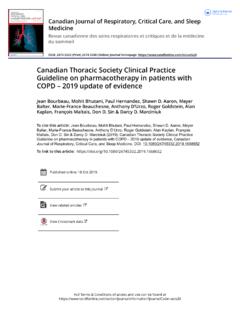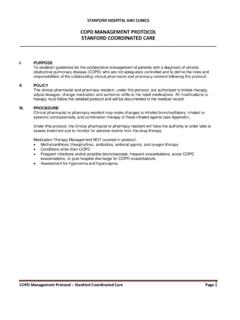Transcription of STOPP START Toolkit
1 STOPP START Toolkit Supporting Medication review STOPP : Screening Tool of Older People s Potentially Inappropriate Prescriptions START : Screening Tool to Alert Doctors to Right ( appropriate, indicated) Treatments Contents Introduction Gastrointestinal BNF Section 1 Cardiovascular System BNF Section 2 Respiratory System BNF Section 3 Central Nervous System and Analgesic Drugs BNF Section 4 Endocrine System BNF Section 6 Urogenital System BNF Section 7 Musculoskeletal System BNF Section 10 References STOPP : Screening Tool of Older People s Potentially Inappropriate Prescriptions 1 Prescriptions that are potentially inappropriate in persons aged 65 years of age START .
2 Screening Tool to Alert Doctors to Right ( appropriate, indicated) Treatments 1 Medication that should be considered for people 65 years of age where no contraindications exist Introduction An evidence based approach to prescribing in the elderly A definition of medication review is a structured, critical examination of a patient s medicines with the objective of reaching an agreement with the patient about treatment, optimising the impact of medicines, minimising the number of medication-related problems and reducing waste .2 It is commonly agreed that older people are at greater risk of adverse effects from their medicines due to age related changes in their major organs which in turn alter pharmacokinetics and pharmacodynamics.
3 They also often have multiple co-morbidities leading to drug-drug interactions or cautions and contraindications to preferred treatments. These patients however are often excluded from drug trials making it difficult for a clinician to weigh up the benefits versus risks, let alone explain them to the patient. Furthermore, although with increasing age a patient can move from benefiting from a treatment to being at significant risk from it, there can be difficulty in stopping medication for the fear of being accused of ageism. This document is based on the STOPP START Tool, a medication review tool designed to identify medication where the risks outweigh the benefits in the elderly and vice versa.
4 Eighteen experts in geriatric pharmacotherapy initially contributed to suggesting and then rating the criteria. The STOPP criteria were evaluated (along with Beer s criteria3) against hospital admissions. One third of the patients with "potentially inappropriate prescriptions" according to STOPP criteria presented with an associated adverse drug event. All recommendations from the STOPP START Tool are included here, and where space allows local and national guidance. The recommendations are grouped according to British National Formulary chapters4 with the STOPP items coloured red and the START items on the coloured green. The rationale for the intervention is given in italics.
5 The tool was validated in patients aged 65 and over but there is still a place for clinical judgement in deciding whether a person is "elderly" in terms of the potential effects of medication. Colour Key Medication to consider stopping in patients over 65 from the STOPP Tool1 Medication to consider starting in patients over 65 from the START Tool 1 National and local guidance NICE Guidelines5 Gastrointestinal System BNF Section 1 STOPP Diphenoxylate (co-phenotrope), loperamide or codeine phosphate for treatment of diarrhoea of unknown cause o risk of delayed diagnosis o may exacerbate constipation with overflow diarrhoea o may precipitate toxic megacolon in inflammatory bowel disease o may delay recovery in unrecognised gastroenteritis for treatment of severe infective gastroenteritis bloody diarrhoea.
6 High fever or severe systemic toxicity o risk of exacerbation or protraction of infection Prochlorperazine or metoclopramide in patients with Parkinsonism o risk of exacerbating Parkinsonism Proton pump inhibitor at treatment dose for peptic ulcer disease at full therapeutic dosage for > 8 weeks o risk of unnecessarily prolonged treatment and masking symptoms of gastric cancer; earlier discontinuation or dose reduction for maintenance/ prophylactic treatment of peptic ulcer disease, oesophagitis or GORD o risk of C. difficile Anticholinergic antispasmodic drugs ( hyoscine butylbromide, dicycloverine) for patients with chronic constipation o risk of exacerbation of constipation Stimulant laxatives ( senna, bisacodyl) for patients with intestinal obstruction o risk of bowel perforation Gastrointestinal System BNF Section 1 START Proton Pump Inhibitor for severe gastro-oesophageal acid reflux disease or peptic stricture requiring dilatation.
7 Consider referring to GP for follow-up in community for patients over 80 years old on anti-platelets and SSRIs Fibre supplement for chronic, symptomatic diverticular disease with constipation Gastrointestinal System BNF Section 1 National and local guidance NICE Guidelines MUST Tool review need for enteral nutrition. Assess patient according to MUST Tool: This document is located in all patient notes at ELHT. Re-Feeding Syndrome Local guidance available via the intranet homepage: Home page: Policies and Procedures>Search: Re-feeding NICE CG17 Dyspepsia Cardiovascular System BNF Section 2 STOPP Digoxin at a long-term dose >125microgram/day with impaired renal function (eGFR <50mL/minute) o increased risk of toxicity ( nausea, diarrhoea, arrhythmias) levels can be taken (must be > 6 hours post dose) if there is a risk of toxicity and/or toxicity suspected Loop diuretic ( furosemide, bumetanide) for dependent ankle oedema only no clinical signs of heart failure o no evidence of efficacy compression hosiery usually more appropriate as first-line monotherapy for hypertension o safer, more effective alternatives available Thiazide diuretic ( bendroflumethiazide)
8 With a history of gout o risk of exacerbating gout Beta-blocker in combination with verapamil o risk of symptomatic heart block Non-cardioselective beta-blocker ( propranolol, sotalol) in patients with copd o risk of bronchospasm Calcium channel blockers with chronic constipation o may exacerbate constipation Use of diltiazem or verapamil with NYHA Class III or IV heart failure o may worsen heart failure if ankle oedema present o may be result of calcium channel blocker Vasodilator drugs ( hydralazine, minoxidil) with persistent postural hypotension recurrent > 20 mmHg drop in systolic blood pressure o risk of syncope and falls stop if patient has fallen in past 3 months Aspirin at dose >150 mg/day.
9 Restart at 75mg if still indicated o increased bleeding risk, no evidence for increased efficacy with concurrent bleeding disorder o high risk of bleeding Warfarin after 6 months of treatment for first, uncomplicated deep venous thrombosis o no proven added benefit beyond 6 months after 12 months of treatment for first uncomplicated pulmonary embolus o no proven benefit beyond 12 months with concurrent bleeding disorder o high risk of bleeding hepatic impairment with impaired clotting ability and raised INR o increased risk of bleeding as a result of impaired ability to produce clotting factors Clopidogrel with concurrent bleeding disorder o high risk of bleeding Dipyridamole as monotherapy for cardiovascular secondary prevention, unless intolerant to aspirin and clopidogrel (secondary prevention TIA)
10 O no evidence for efficacy with concurrent bleeding disorder o high risk of bleeding immediate release tablets o no evidence for efficacy and non-formulary Statins Atorvastatin 80mg for longer than 6 months post-MI o Reduce to maintenance simvastatin after this period except in exceptional circumstances highlighted in the Trust formulary In patients displaying symptoms of muscle weakness and pain o Risk of myopathy and rhabdomyolysis Check creatinine kinase if patient presents with muscular symptoms START Cardiovascular System BNF Section 2 Warfarin in the presence of chronic atrial fibrillation following diagnosis of deep vein thrombosis or pulmonary embolism if benefit outweighs risk of treatment Aspirin in the presence of chronic atrial fibrillation, where warfarin is contraindicated, but not aspirin Aspirin or clopidogrel with a documented history of atherosclerotic coronary, cerebral or peripheral vascular disease in patients with sinus rhythm following an acute myocardial infarction Antihypertensive therapy where systolic blood pressure consistently >160 mmHg Statin therapy with a documented history of coronary, cerebral or peripheral vascular disease Angiotensin Converting Enzyme (ACE)


